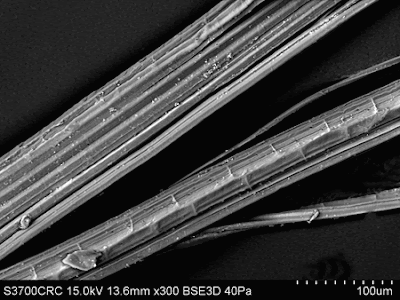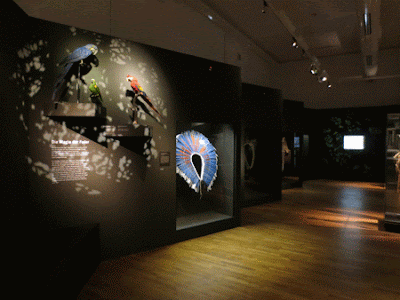A visit
to the British Museum’s Department of Conservation and Scientific Research, was
an opportunity to catch up with the analytical work being undertaken by
Caroline Cartwright, Senior Scientist, on items from the Cook-Voyage
Collections. Prepared for a brief synopsis of the findings I was delighted that
Caroline also took the time to run through her methodology, and the use of the
scanning electron microscope (SEM).
 |
| The VP-SEM showing images on the screen of 1884.29.5 .1 Pteropus (Flying Fox) hair being identified by C.R.Cartwright. Caroline R. Cartwright © Trustees of the British Museum |
Briefly,
for those unfamiliar with the technique, the SEM works by scanning a beam of
electrons onto the surface of an object, generating signals to form a black and
white, three-dimensional image of its surface. This image is clear and detailed,
and can be produced at very high magnification (up to several thousand times).
Caroline is using this technology for fibre identification of samples taken
from a number of the Pitt Rivers Cook-Voyage items, the clarity of the images
enabling diagnostic scale patterns or other surface features of the natural
fibres to be identified.
Items for
sampling were chosen carefully by Jeremy, including a ‘twig-like’ material from
the Tahitian Mourner’s costume cloak, as well as barkcloth, and plant material
used to decorate it, from Easter Island. This is one of the few flat barkcloths
in existence from Easter Island and therefore of particular value in terms of
the information it holds. The research may assist in determining not only
composition but possibly also provenance of some of the materials chosen. For
example, preliminary analysis of the cord from a fishhook, thought to originate
from Hawaii, indicates in fact that the fibre is New Zealand flax. Similarly,
plant material from a sling has been documented as originating from New
Caledonia, although assessment indicates it might in fact come from Tahiti.
 |
| New Zealand flax fibre from fish hook 1887.1.379. Image: Caroline R. Cartwright |
By using
a ‘variable pressure’ SEM, Caroline is able to scan these non-conductive, organic
fibres without firstly coating them with a conductive material. This not only
enables her to view the samples without distraction but also leaves them ‘uncontaminated’
for potential future analysis, which is a huge bonus when working with such unique
material where sample taking must be restricted. The process is not as
straightforward as it might appear, diagnosis being only as good as the quality
of the sample, the breadth (and knowledge) of a sample reference library, and
the condition of the fibres which, after 250 years or more, are not as pristine
as they once were. However, Caroline has a wealth of experience in this
department and has made some exciting progress. Already, she has been able to
confirm that a sample of brown hair from a New Caledonian sling stone string bag
is indeed made from the fur of the flying fox, and we look forward to more
discoveries.
 |
| Flying fox fur from New Caledonian bag 1884.29.5 .1. Image: Caroline R. Cartwright |
Somehow, in
two enjoyable and informative hours, Caroline managed to dispel a year’s worth
of bewildering lectures and encounters with the scanning electron microscope,
and for that alone I’m truly grateful! Thank you to the Friends of the Pitt
Rivers who funded this opportunity, as well as all those at the British Museum
and the Pitt Rivers who made this visit possible.

















